Glocalization and Global Marketing Mix of Nestle and Coca-Cola Company
VerifiedAdded on 2023/06/07
|10
|2770
|58
AI Summary
This article discusses the concept of glocalization and its importance in global marketing. It analyzes the standardization and adaptation strategies of Nestle and Coca-Cola Company in their global marketing mix. The article also explores the advantages and disadvantages of both strategies and how companies can find an optimal solution between them. The study concludes that glocalization is a journey and requires keen analysis of cultural, social, demographic, legal, political, and natural factors in each marketing mix.
Contribute Materials
Your contribution can guide someone’s learning journey. Share your
documents today.
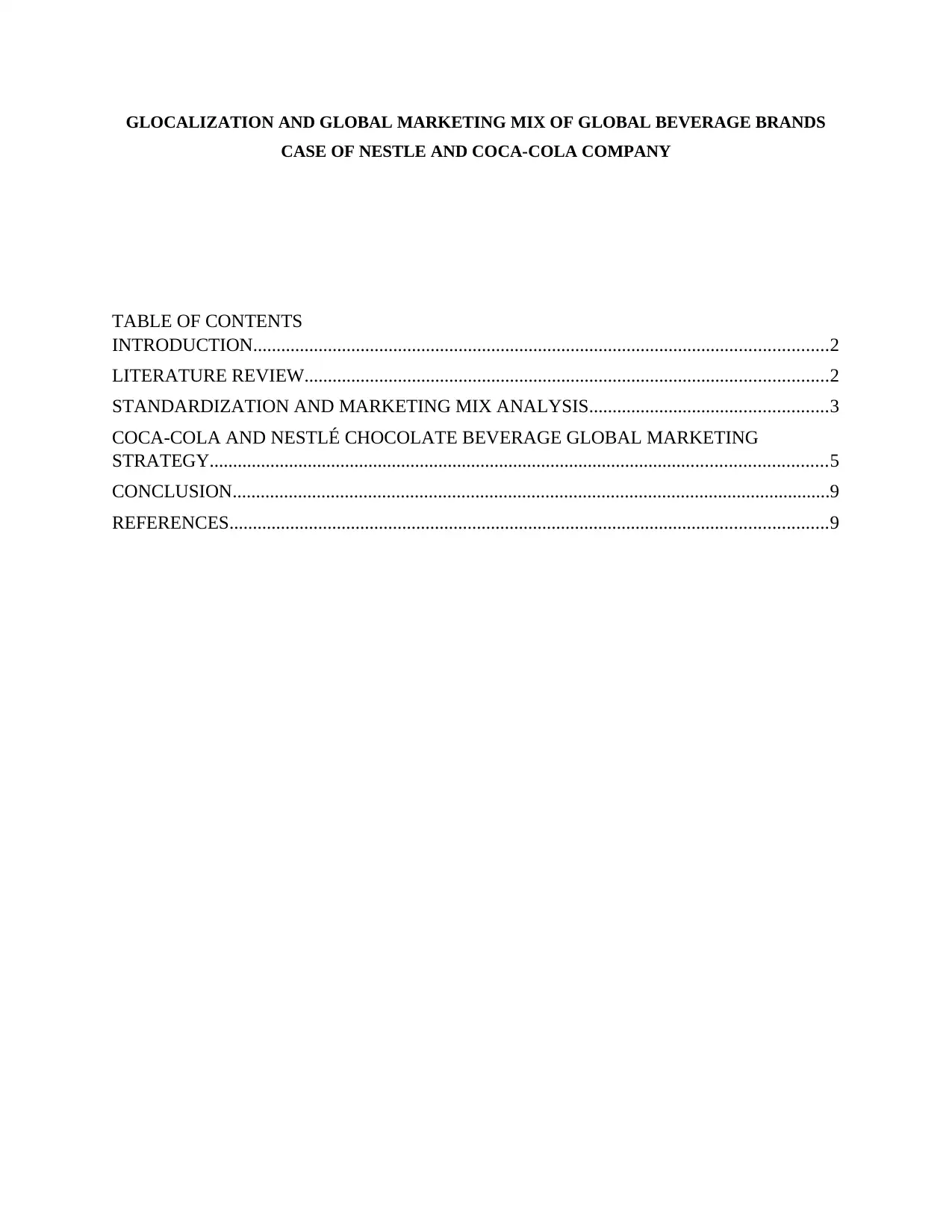
GLOCALIZATION AND GLOBAL MARKETING MIX OF GLOBAL BEVERAGE BRANDS
CASE OF NESTLE AND COCA-COLA COMPANY
TABLE OF CONTENTS
INTRODUCTION...........................................................................................................................2
LITERATURE REVIEW................................................................................................................2
STANDARDIZATION AND MARKETING MIX ANALYSIS...................................................3
COCA-COLA AND NESTLÉ CHOCOLATE BEVERAGE GLOBAL MARKETING
STRATEGY....................................................................................................................................5
CONCLUSION................................................................................................................................9
REFERENCES................................................................................................................................9
CASE OF NESTLE AND COCA-COLA COMPANY
TABLE OF CONTENTS
INTRODUCTION...........................................................................................................................2
LITERATURE REVIEW................................................................................................................2
STANDARDIZATION AND MARKETING MIX ANALYSIS...................................................3
COCA-COLA AND NESTLÉ CHOCOLATE BEVERAGE GLOBAL MARKETING
STRATEGY....................................................................................................................................5
CONCLUSION................................................................................................................................9
REFERENCES................................................................................................................................9
Secure Best Marks with AI Grader
Need help grading? Try our AI Grader for instant feedback on your assignments.
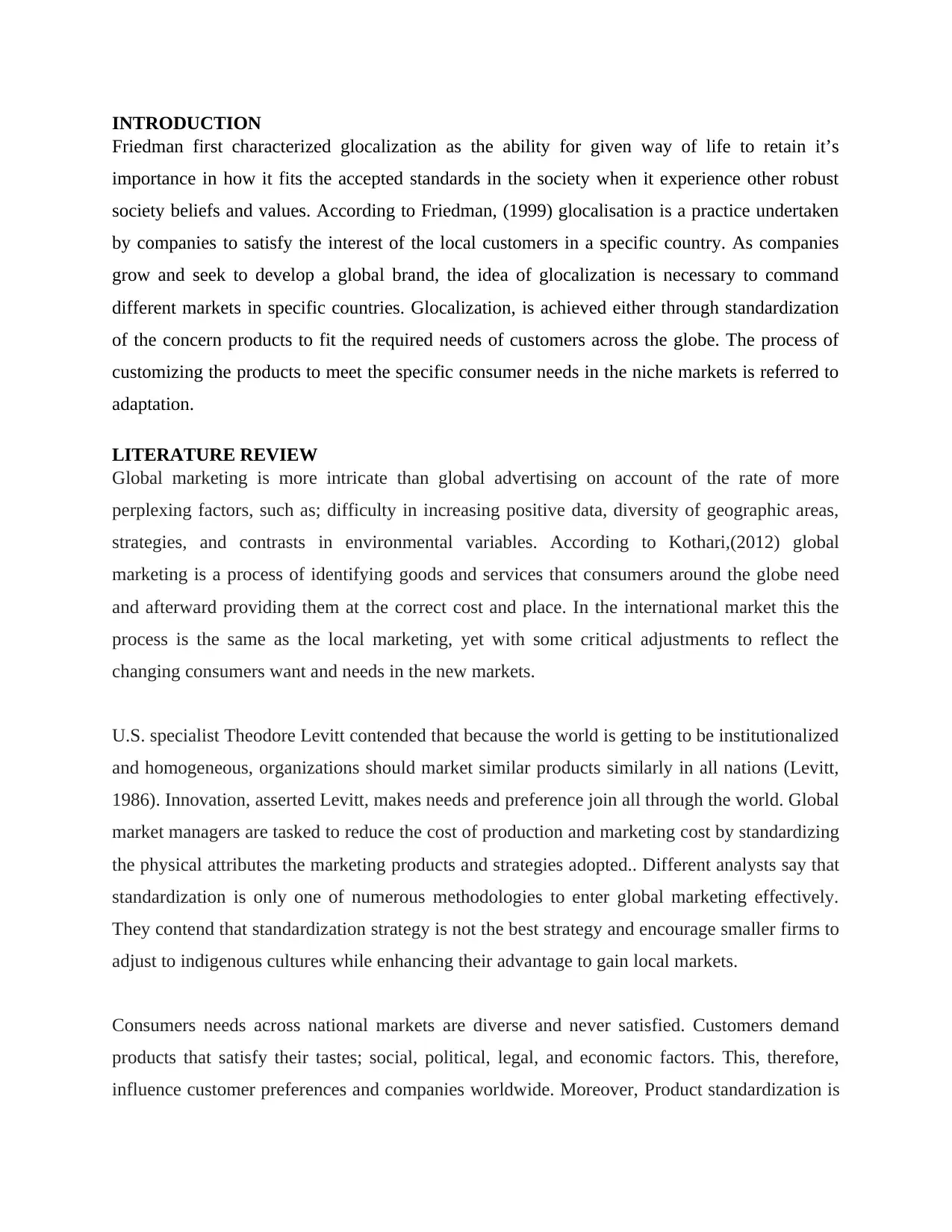
INTRODUCTION
Friedman first characterized glocalization as the ability for given way of life to retain it’s
importance in how it fits the accepted standards in the society when it experience other robust
society beliefs and values. According to Friedman, (1999) glocalisation is a practice undertaken
by companies to satisfy the interest of the local customers in a specific country. As companies
grow and seek to develop a global brand, the idea of glocalization is necessary to command
different markets in specific countries. Glocalization, is achieved either through standardization
of the concern products to fit the required needs of customers across the globe. The process of
customizing the products to meet the specific consumer needs in the niche markets is referred to
adaptation.
LITERATURE REVIEW
Global marketing is more intricate than global advertising on account of the rate of more
perplexing factors, such as; difficulty in increasing positive data, diversity of geographic areas,
strategies, and contrasts in environmental variables. According to Kothari,(2012) global
marketing is a process of identifying goods and services that consumers around the globe need
and afterward providing them at the correct cost and place. In the international market this the
process is the same as the local marketing, yet with some critical adjustments to reflect the
changing consumers want and needs in the new markets.
U.S. specialist Theodore Levitt contended that because the world is getting to be institutionalized
and homogeneous, organizations should market similar products similarly in all nations (Levitt,
1986). Innovation, asserted Levitt, makes needs and preference join all through the world. Global
market managers are tasked to reduce the cost of production and marketing cost by standardizing
the physical attributes the marketing products and strategies adopted.. Different analysts say that
standardization is only one of numerous methodologies to enter global marketing effectively.
They contend that standardization strategy is not the best strategy and encourage smaller firms to
adjust to indigenous cultures while enhancing their advantage to gain local markets.
Consumers needs across national markets are diverse and never satisfied. Customers demand
products that satisfy their tastes; social, political, legal, and economic factors. This, therefore,
influence customer preferences and companies worldwide. Moreover, Product standardization is
Friedman first characterized glocalization as the ability for given way of life to retain it’s
importance in how it fits the accepted standards in the society when it experience other robust
society beliefs and values. According to Friedman, (1999) glocalisation is a practice undertaken
by companies to satisfy the interest of the local customers in a specific country. As companies
grow and seek to develop a global brand, the idea of glocalization is necessary to command
different markets in specific countries. Glocalization, is achieved either through standardization
of the concern products to fit the required needs of customers across the globe. The process of
customizing the products to meet the specific consumer needs in the niche markets is referred to
adaptation.
LITERATURE REVIEW
Global marketing is more intricate than global advertising on account of the rate of more
perplexing factors, such as; difficulty in increasing positive data, diversity of geographic areas,
strategies, and contrasts in environmental variables. According to Kothari,(2012) global
marketing is a process of identifying goods and services that consumers around the globe need
and afterward providing them at the correct cost and place. In the international market this the
process is the same as the local marketing, yet with some critical adjustments to reflect the
changing consumers want and needs in the new markets.
U.S. specialist Theodore Levitt contended that because the world is getting to be institutionalized
and homogeneous, organizations should market similar products similarly in all nations (Levitt,
1986). Innovation, asserted Levitt, makes needs and preference join all through the world. Global
market managers are tasked to reduce the cost of production and marketing cost by standardizing
the physical attributes the marketing products and strategies adopted.. Different analysts say that
standardization is only one of numerous methodologies to enter global marketing effectively.
They contend that standardization strategy is not the best strategy and encourage smaller firms to
adjust to indigenous cultures while enhancing their advantage to gain local markets.
Consumers needs across national markets are diverse and never satisfied. Customers demand
products that satisfy their tastes; social, political, legal, and economic factors. This, therefore,
influence customer preferences and companies worldwide. Moreover, Product standardization is
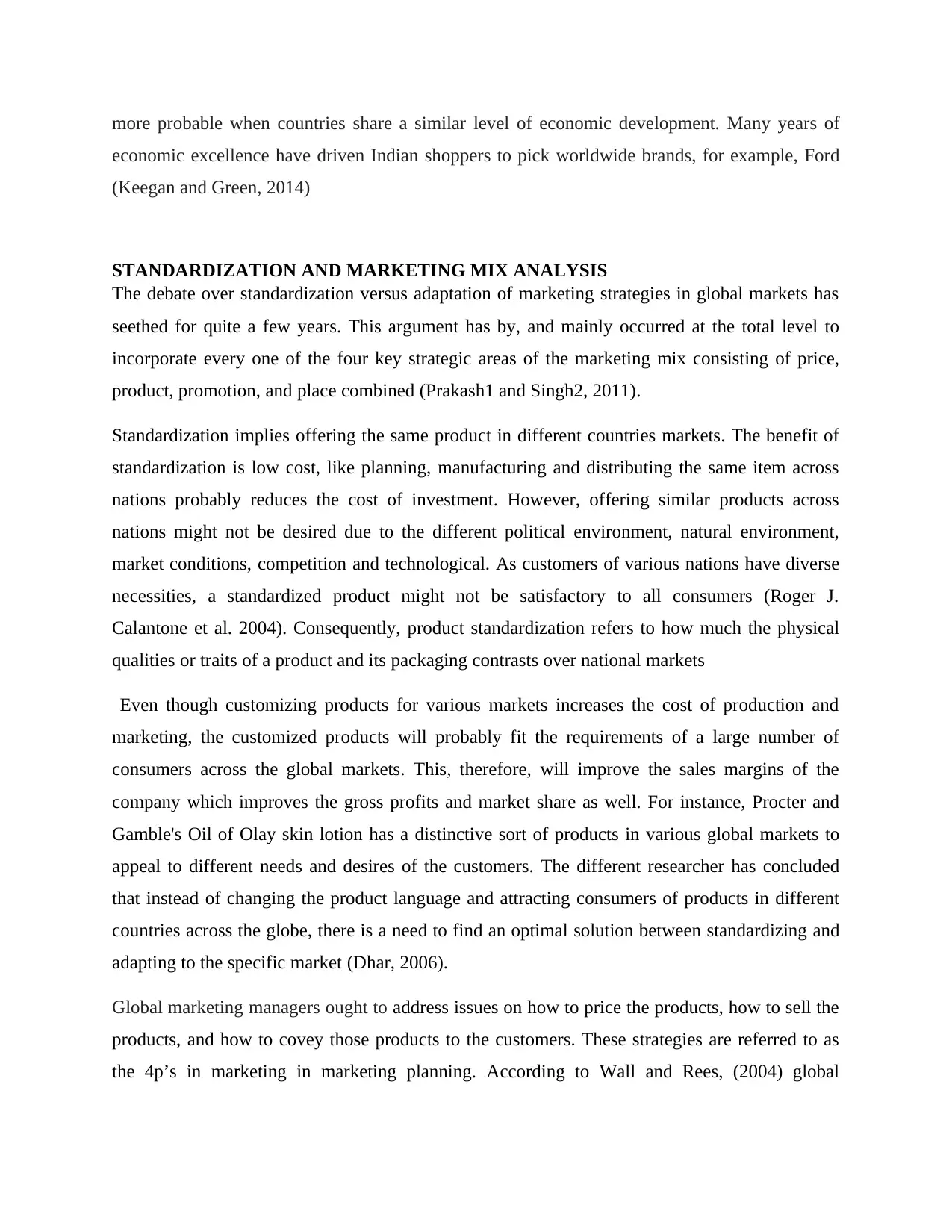
more probable when countries share a similar level of economic development. Many years of
economic excellence have driven Indian shoppers to pick worldwide brands, for example, Ford
(Keegan and Green, 2014)
STANDARDIZATION AND MARKETING MIX ANALYSIS
The debate over standardization versus adaptation of marketing strategies in global markets has
seethed for quite a few years. This argument has by, and mainly occurred at the total level to
incorporate every one of the four key strategic areas of the marketing mix consisting of price,
product, promotion, and place combined (Prakash1 and Singh2, 2011).
Standardization implies offering the same product in different countries markets. The benefit of
standardization is low cost, like planning, manufacturing and distributing the same item across
nations probably reduces the cost of investment. However, offering similar products across
nations might not be desired due to the different political environment, natural environment,
market conditions, competition and technological. As customers of various nations have diverse
necessities, a standardized product might not be satisfactory to all consumers (Roger J.
Calantone et al. 2004). Consequently, product standardization refers to how much the physical
qualities or traits of a product and its packaging contrasts over national markets
Even though customizing products for various markets increases the cost of production and
marketing, the customized products will probably fit the requirements of a large number of
consumers across the global markets. This, therefore, will improve the sales margins of the
company which improves the gross profits and market share as well. For instance, Procter and
Gamble's Oil of Olay skin lotion has a distinctive sort of products in various global markets to
appeal to different needs and desires of the customers. The different researcher has concluded
that instead of changing the product language and attracting consumers of products in different
countries across the globe, there is a need to find an optimal solution between standardizing and
adapting to the specific market (Dhar, 2006).
Global marketing managers ought to address issues on how to price the products, how to sell the
products, and how to covey those products to the customers. These strategies are referred to as
the 4p’s in marketing in marketing planning. According to Wall and Rees, (2004) global
economic excellence have driven Indian shoppers to pick worldwide brands, for example, Ford
(Keegan and Green, 2014)
STANDARDIZATION AND MARKETING MIX ANALYSIS
The debate over standardization versus adaptation of marketing strategies in global markets has
seethed for quite a few years. This argument has by, and mainly occurred at the total level to
incorporate every one of the four key strategic areas of the marketing mix consisting of price,
product, promotion, and place combined (Prakash1 and Singh2, 2011).
Standardization implies offering the same product in different countries markets. The benefit of
standardization is low cost, like planning, manufacturing and distributing the same item across
nations probably reduces the cost of investment. However, offering similar products across
nations might not be desired due to the different political environment, natural environment,
market conditions, competition and technological. As customers of various nations have diverse
necessities, a standardized product might not be satisfactory to all consumers (Roger J.
Calantone et al. 2004). Consequently, product standardization refers to how much the physical
qualities or traits of a product and its packaging contrasts over national markets
Even though customizing products for various markets increases the cost of production and
marketing, the customized products will probably fit the requirements of a large number of
consumers across the global markets. This, therefore, will improve the sales margins of the
company which improves the gross profits and market share as well. For instance, Procter and
Gamble's Oil of Olay skin lotion has a distinctive sort of products in various global markets to
appeal to different needs and desires of the customers. The different researcher has concluded
that instead of changing the product language and attracting consumers of products in different
countries across the globe, there is a need to find an optimal solution between standardizing and
adapting to the specific market (Dhar, 2006).
Global marketing managers ought to address issues on how to price the products, how to sell the
products, and how to covey those products to the customers. These strategies are referred to as
the 4p’s in marketing in marketing planning. According to Wall and Rees, (2004) global
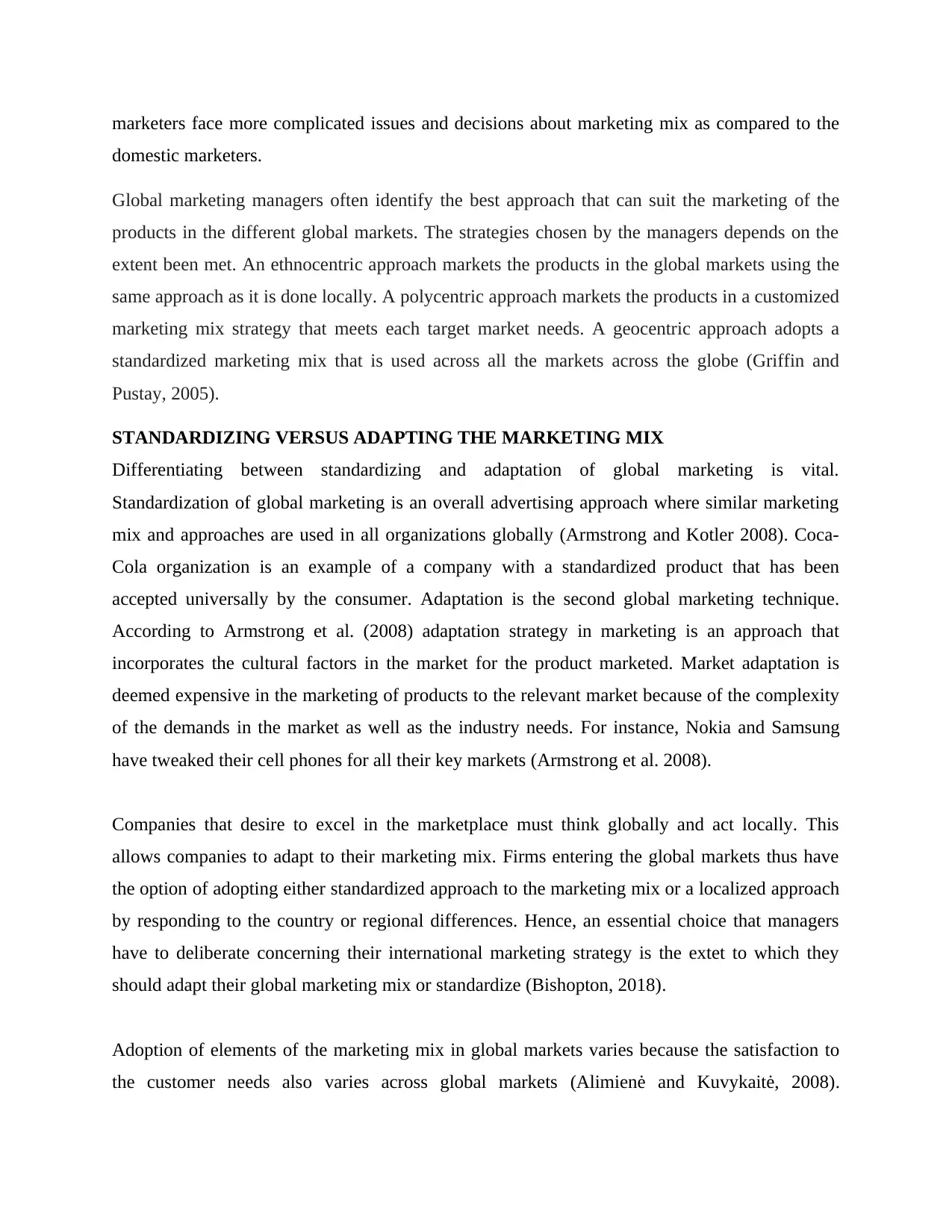
marketers face more complicated issues and decisions about marketing mix as compared to the
domestic marketers.
Global marketing managers often identify the best approach that can suit the marketing of the
products in the different global markets. The strategies chosen by the managers depends on the
extent been met. An ethnocentric approach markets the products in the global markets using the
same approach as it is done locally. A polycentric approach markets the products in a customized
marketing mix strategy that meets each target market needs. A geocentric approach adopts a
standardized marketing mix that is used across all the markets across the globe (Griffin and
Pustay, 2005).
STANDARDIZING VERSUS ADAPTING THE MARKETING MIX
Differentiating between standardizing and adaptation of global marketing is vital.
Standardization of global marketing is an overall advertising approach where similar marketing
mix and approaches are used in all organizations globally (Armstrong and Kotler 2008). Coca-
Cola organization is an example of a company with a standardized product that has been
accepted universally by the consumer. Adaptation is the second global marketing technique.
According to Armstrong et al. (2008) adaptation strategy in marketing is an approach that
incorporates the cultural factors in the market for the product marketed. Market adaptation is
deemed expensive in the marketing of products to the relevant market because of the complexity
of the demands in the market as well as the industry needs. For instance, Nokia and Samsung
have tweaked their cell phones for all their key markets (Armstrong et al. 2008).
Companies that desire to excel in the marketplace must think globally and act locally. This
allows companies to adapt to their marketing mix. Firms entering the global markets thus have
the option of adopting either standardized approach to the marketing mix or a localized approach
by responding to the country or regional differences. Hence, an essential choice that managers
have to deliberate concerning their international marketing strategy is the extet to which they
should adapt their global marketing mix or standardize (Bishopton, 2018).
Adoption of elements of the marketing mix in global markets varies because the satisfaction to
the customer needs also varies across global markets (Alimienė and Kuvykaitė, 2008).
domestic marketers.
Global marketing managers often identify the best approach that can suit the marketing of the
products in the different global markets. The strategies chosen by the managers depends on the
extent been met. An ethnocentric approach markets the products in the global markets using the
same approach as it is done locally. A polycentric approach markets the products in a customized
marketing mix strategy that meets each target market needs. A geocentric approach adopts a
standardized marketing mix that is used across all the markets across the globe (Griffin and
Pustay, 2005).
STANDARDIZING VERSUS ADAPTING THE MARKETING MIX
Differentiating between standardizing and adaptation of global marketing is vital.
Standardization of global marketing is an overall advertising approach where similar marketing
mix and approaches are used in all organizations globally (Armstrong and Kotler 2008). Coca-
Cola organization is an example of a company with a standardized product that has been
accepted universally by the consumer. Adaptation is the second global marketing technique.
According to Armstrong et al. (2008) adaptation strategy in marketing is an approach that
incorporates the cultural factors in the market for the product marketed. Market adaptation is
deemed expensive in the marketing of products to the relevant market because of the complexity
of the demands in the market as well as the industry needs. For instance, Nokia and Samsung
have tweaked their cell phones for all their key markets (Armstrong et al. 2008).
Companies that desire to excel in the marketplace must think globally and act locally. This
allows companies to adapt to their marketing mix. Firms entering the global markets thus have
the option of adopting either standardized approach to the marketing mix or a localized approach
by responding to the country or regional differences. Hence, an essential choice that managers
have to deliberate concerning their international marketing strategy is the extet to which they
should adapt their global marketing mix or standardize (Bishopton, 2018).
Adoption of elements of the marketing mix in global markets varies because the satisfaction to
the customer needs also varies across global markets (Alimienė and Kuvykaitė, 2008).
Secure Best Marks with AI Grader
Need help grading? Try our AI Grader for instant feedback on your assignments.
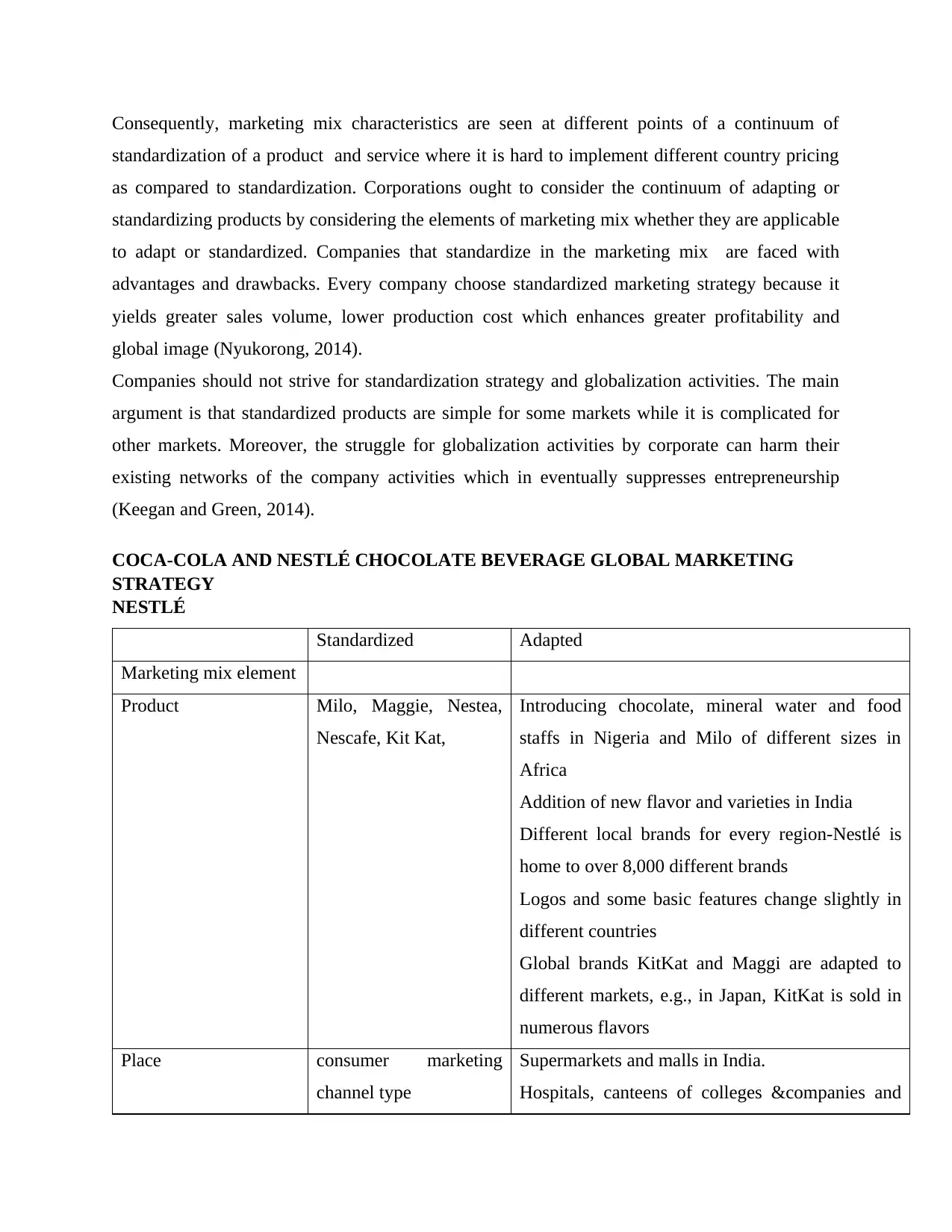
Consequently, marketing mix characteristics are seen at different points of a continuum of
standardization of a product and service where it is hard to implement different country pricing
as compared to standardization. Corporations ought to consider the continuum of adapting or
standardizing products by considering the elements of marketing mix whether they are applicable
to adapt or standardized. Companies that standardize in the marketing mix are faced with
advantages and drawbacks. Every company choose standardized marketing strategy because it
yields greater sales volume, lower production cost which enhances greater profitability and
global image (Nyukorong, 2014).
Companies should not strive for standardization strategy and globalization activities. The main
argument is that standardized products are simple for some markets while it is complicated for
other markets. Moreover, the struggle for globalization activities by corporate can harm their
existing networks of the company activities which in eventually suppresses entrepreneurship
(Keegan and Green, 2014).
COCA-COLA AND NESTLÉ CHOCOLATE BEVERAGE GLOBAL MARKETING
STRATEGY
NESTLÉ
Standardized Adapted
Marketing mix element
Product Milo, Maggie, Nestea,
Nescafe, Kit Kat,
Introducing chocolate, mineral water and food
staffs in Nigeria and Milo of different sizes in
Africa
Addition of new flavor and varieties in India
Different local brands for every region-Nestlé is
home to over 8,000 different brands
Logos and some basic features change slightly in
different countries
Global brands KitKat and Maggi are adapted to
different markets, e.g., in Japan, KitKat is sold in
numerous flavors
Place consumer marketing
channel type
Supermarkets and malls in India.
Hospitals, canteens of colleges &companies and
standardization of a product and service where it is hard to implement different country pricing
as compared to standardization. Corporations ought to consider the continuum of adapting or
standardizing products by considering the elements of marketing mix whether they are applicable
to adapt or standardized. Companies that standardize in the marketing mix are faced with
advantages and drawbacks. Every company choose standardized marketing strategy because it
yields greater sales volume, lower production cost which enhances greater profitability and
global image (Nyukorong, 2014).
Companies should not strive for standardization strategy and globalization activities. The main
argument is that standardized products are simple for some markets while it is complicated for
other markets. Moreover, the struggle for globalization activities by corporate can harm their
existing networks of the company activities which in eventually suppresses entrepreneurship
(Keegan and Green, 2014).
COCA-COLA AND NESTLÉ CHOCOLATE BEVERAGE GLOBAL MARKETING
STRATEGY
NESTLÉ
Standardized Adapted
Marketing mix element
Product Milo, Maggie, Nestea,
Nescafe, Kit Kat,
Introducing chocolate, mineral water and food
staffs in Nigeria and Milo of different sizes in
Africa
Addition of new flavor and varieties in India
Different local brands for every region-Nestlé is
home to over 8,000 different brands
Logos and some basic features change slightly in
different countries
Global brands KitKat and Maggi are adapted to
different markets, e.g., in Japan, KitKat is sold in
numerous flavors
Place consumer marketing
channel type
Supermarkets and malls in India.
Hospitals, canteens of colleges &companies and
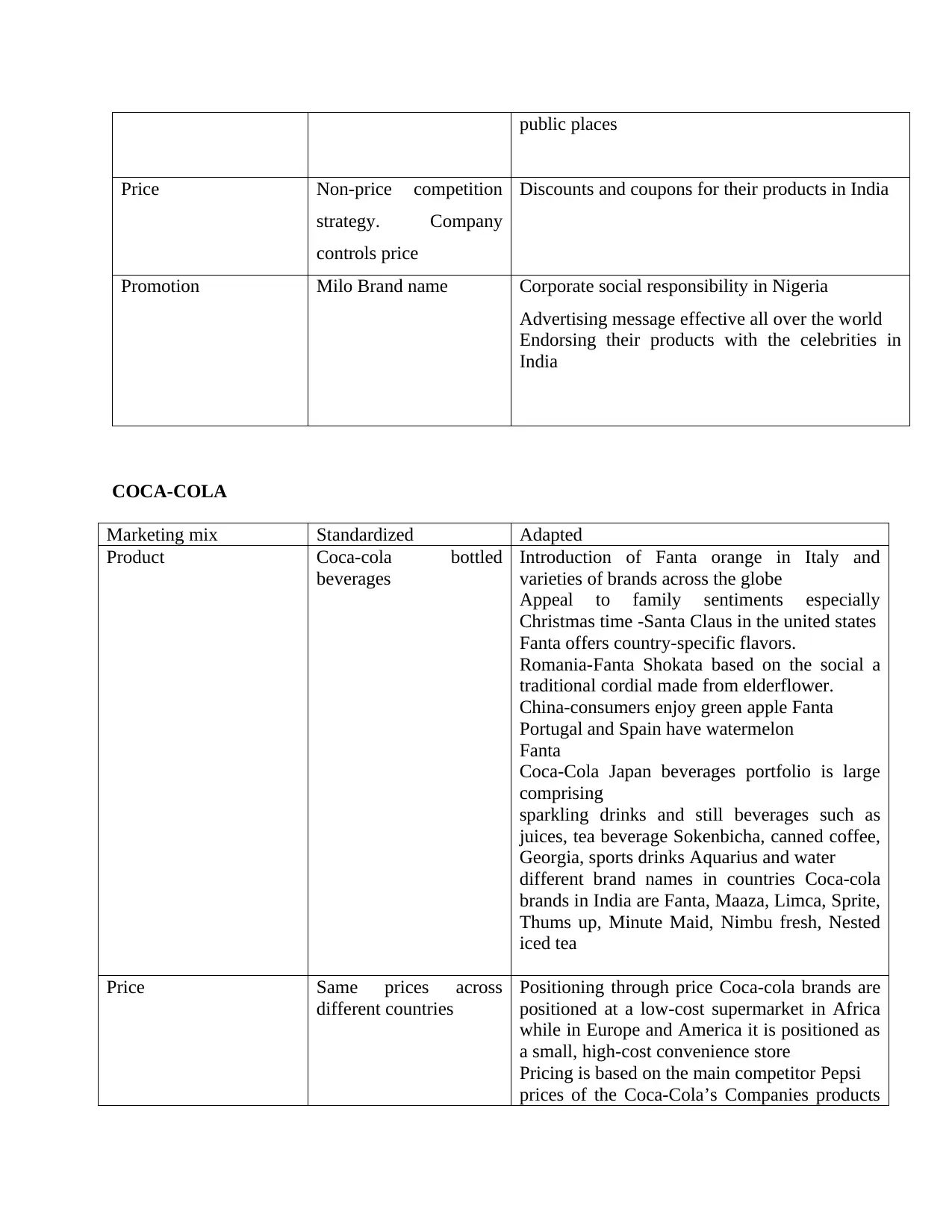
public places
Price Non-price competition
strategy. Company
controls price
Discounts and coupons for their products in India
Promotion Milo Brand name Corporate social responsibility in Nigeria
Advertising message effective all over the world
Endorsing their products with the celebrities in
India
COCA-COLA
Marketing mix Standardized Adapted
Product Coca-cola bottled
beverages
Introduction of Fanta orange in Italy and
varieties of brands across the globe
Appeal to family sentiments especially
Christmas time -Santa Claus in the united states
Fanta offers country-specific flavors.
Romania-Fanta Shokata based on the social a
traditional cordial made from elderflower.
China-consumers enjoy green apple Fanta
Portugal and Spain have watermelon
Fanta
Coca-Cola Japan beverages portfolio is large
comprising
sparkling drinks and still beverages such as
juices, tea beverage Sokenbicha, canned coffee,
Georgia, sports drinks Aquarius and water
different brand names in countries Coca-cola
brands in India are Fanta, Maaza, Limca, Sprite,
Thums up, Minute Maid, Nimbu fresh, Nested
iced tea
Price Same prices across
different countries
Positioning through price Coca-cola brands are
positioned at a low-cost supermarket in Africa
while in Europe and America it is positioned as
a small, high-cost convenience store
Pricing is based on the main competitor Pepsi
prices of the Coca-Cola’s Companies products
Price Non-price competition
strategy. Company
controls price
Discounts and coupons for their products in India
Promotion Milo Brand name Corporate social responsibility in Nigeria
Advertising message effective all over the world
Endorsing their products with the celebrities in
India
COCA-COLA
Marketing mix Standardized Adapted
Product Coca-cola bottled
beverages
Introduction of Fanta orange in Italy and
varieties of brands across the globe
Appeal to family sentiments especially
Christmas time -Santa Claus in the united states
Fanta offers country-specific flavors.
Romania-Fanta Shokata based on the social a
traditional cordial made from elderflower.
China-consumers enjoy green apple Fanta
Portugal and Spain have watermelon
Fanta
Coca-Cola Japan beverages portfolio is large
comprising
sparkling drinks and still beverages such as
juices, tea beverage Sokenbicha, canned coffee,
Georgia, sports drinks Aquarius and water
different brand names in countries Coca-cola
brands in India are Fanta, Maaza, Limca, Sprite,
Thums up, Minute Maid, Nimbu fresh, Nested
iced tea
Price Same prices across
different countries
Positioning through price Coca-cola brands are
positioned at a low-cost supermarket in Africa
while in Europe and America it is positioned as
a small, high-cost convenience store
Pricing is based on the main competitor Pepsi
prices of the Coca-Cola’s Companies products
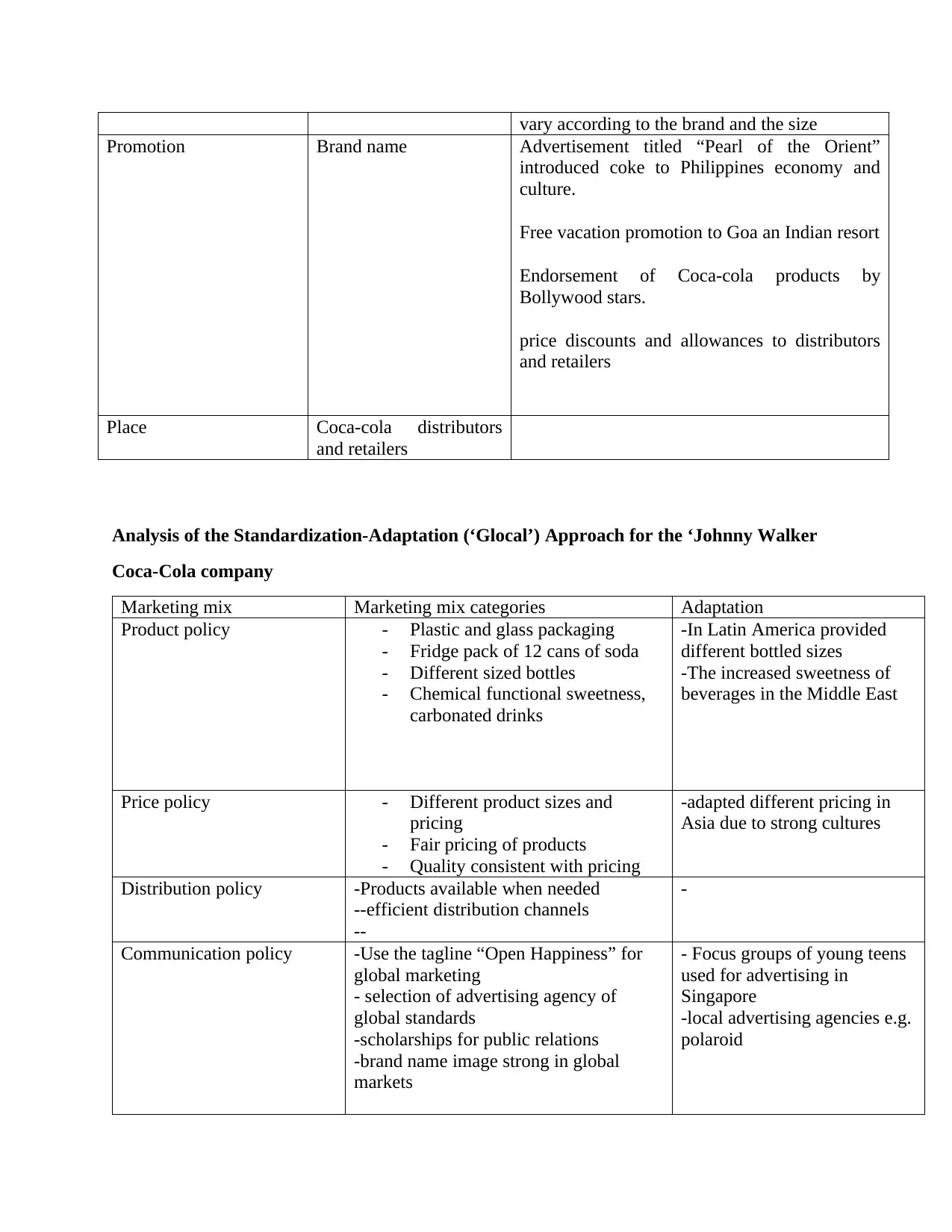
vary according to the brand and the size
Promotion Brand name Advertisement titled “Pearl of the Orient”
introduced coke to Philippines economy and
culture.
Free vacation promotion to Goa an Indian resort
Endorsement of Coca-cola products by
Bollywood stars.
price discounts and allowances to distributors
and retailers
Place Coca-cola distributors
and retailers
Analysis of the Standardization-Adaptation (‘Glocal’) Approach for the ‘Johnny Walker
Coca-Cola company
Marketing mix Marketing mix categories Adaptation
Product policy - Plastic and glass packaging
- Fridge pack of 12 cans of soda
- Different sized bottles
- Chemical functional sweetness,
carbonated drinks
-In Latin America provided
different bottled sizes
-The increased sweetness of
beverages in the Middle East
Price policy - Different product sizes and
pricing
- Fair pricing of products
- Quality consistent with pricing
-adapted different pricing in
Asia due to strong cultures
Distribution policy -Products available when needed
--efficient distribution channels
--
-
Communication policy -Use the tagline “Open Happiness” for
global marketing
- selection of advertising agency of
global standards
-scholarships for public relations
-brand name image strong in global
markets
- Focus groups of young teens
used for advertising in
Singapore
-local advertising agencies e.g.
polaroid
Promotion Brand name Advertisement titled “Pearl of the Orient”
introduced coke to Philippines economy and
culture.
Free vacation promotion to Goa an Indian resort
Endorsement of Coca-cola products by
Bollywood stars.
price discounts and allowances to distributors
and retailers
Place Coca-cola distributors
and retailers
Analysis of the Standardization-Adaptation (‘Glocal’) Approach for the ‘Johnny Walker
Coca-Cola company
Marketing mix Marketing mix categories Adaptation
Product policy - Plastic and glass packaging
- Fridge pack of 12 cans of soda
- Different sized bottles
- Chemical functional sweetness,
carbonated drinks
-In Latin America provided
different bottled sizes
-The increased sweetness of
beverages in the Middle East
Price policy - Different product sizes and
pricing
- Fair pricing of products
- Quality consistent with pricing
-adapted different pricing in
Asia due to strong cultures
Distribution policy -Products available when needed
--efficient distribution channels
--
-
Communication policy -Use the tagline “Open Happiness” for
global marketing
- selection of advertising agency of
global standards
-scholarships for public relations
-brand name image strong in global
markets
- Focus groups of young teens
used for advertising in
Singapore
-local advertising agencies e.g.
polaroid
Paraphrase This Document
Need a fresh take? Get an instant paraphrase of this document with our AI Paraphraser
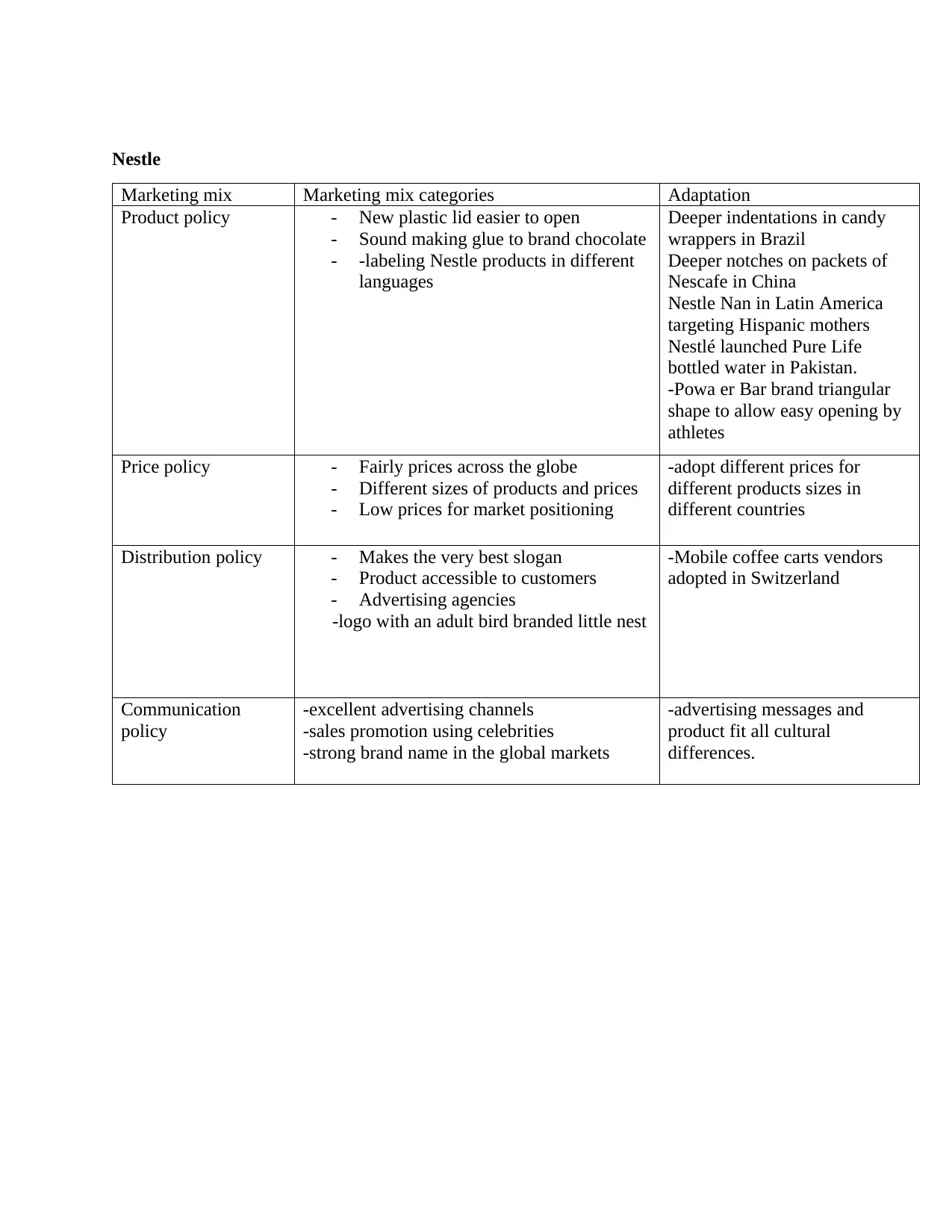
Nestle
Marketing mix Marketing mix categories Adaptation
Product policy - New plastic lid easier to open
- Sound making glue to brand chocolate
- -labeling Nestle products in different
languages
Deeper indentations in candy
wrappers in Brazil
Deeper notches on packets of
Nescafe in China
Nestle Nan in Latin America
targeting Hispanic mothers
Nestlé launched Pure Life
bottled water in Pakistan.
-Powa er Bar brand triangular
shape to allow easy opening by
athletes
Price policy - Fairly prices across the globe
- Different sizes of products and prices
- Low prices for market positioning
-adopt different prices for
different products sizes in
different countries
Distribution policy - Makes the very best slogan
- Product accessible to customers
- Advertising agencies
-logo with an adult bird branded little nest
-Mobile coffee carts vendors
adopted in Switzerland
Communication
policy
-excellent advertising channels
-sales promotion using celebrities
-strong brand name in the global markets
-advertising messages and
product fit all cultural
differences.
Marketing mix Marketing mix categories Adaptation
Product policy - New plastic lid easier to open
- Sound making glue to brand chocolate
- -labeling Nestle products in different
languages
Deeper indentations in candy
wrappers in Brazil
Deeper notches on packets of
Nescafe in China
Nestle Nan in Latin America
targeting Hispanic mothers
Nestlé launched Pure Life
bottled water in Pakistan.
-Powa er Bar brand triangular
shape to allow easy opening by
athletes
Price policy - Fairly prices across the globe
- Different sizes of products and prices
- Low prices for market positioning
-adopt different prices for
different products sizes in
different countries
Distribution policy - Makes the very best slogan
- Product accessible to customers
- Advertising agencies
-logo with an adult bird branded little nest
-Mobile coffee carts vendors
adopted in Switzerland
Communication
policy
-excellent advertising channels
-sales promotion using celebrities
-strong brand name in the global markets
-advertising messages and
product fit all cultural
differences.
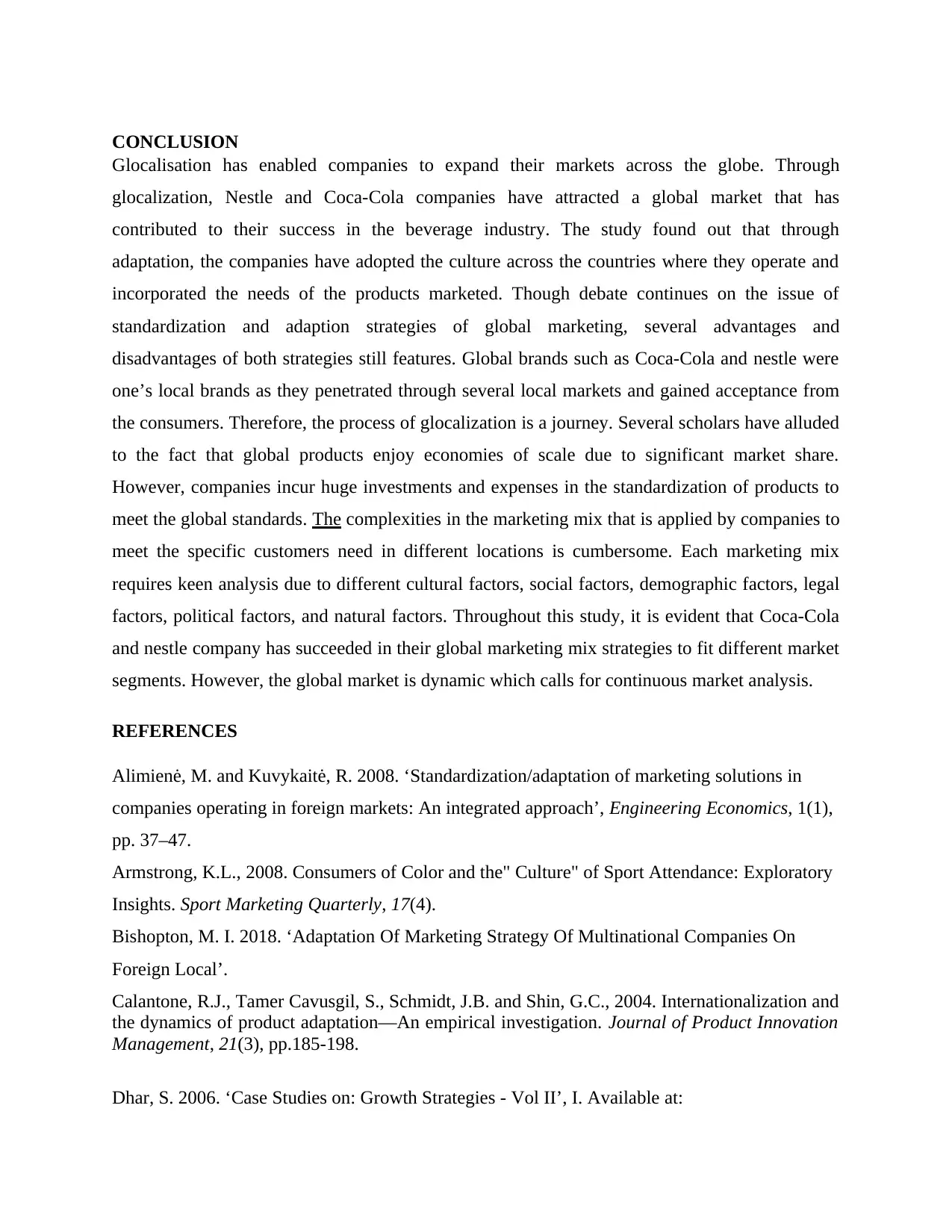
CONCLUSION
Glocalisation has enabled companies to expand their markets across the globe. Through
glocalization, Nestle and Coca-Cola companies have attracted a global market that has
contributed to their success in the beverage industry. The study found out that through
adaptation, the companies have adopted the culture across the countries where they operate and
incorporated the needs of the products marketed. Though debate continues on the issue of
standardization and adaption strategies of global marketing, several advantages and
disadvantages of both strategies still features. Global brands such as Coca-Cola and nestle were
one’s local brands as they penetrated through several local markets and gained acceptance from
the consumers. Therefore, the process of glocalization is a journey. Several scholars have alluded
to the fact that global products enjoy economies of scale due to significant market share.
However, companies incur huge investments and expenses in the standardization of products to
meet the global standards. The complexities in the marketing mix that is applied by companies to
meet the specific customers need in different locations is cumbersome. Each marketing mix
requires keen analysis due to different cultural factors, social factors, demographic factors, legal
factors, political factors, and natural factors. Throughout this study, it is evident that Coca-Cola
and nestle company has succeeded in their global marketing mix strategies to fit different market
segments. However, the global market is dynamic which calls for continuous market analysis.
REFERENCES
Alimienė, M. and Kuvykaitė, R. 2008. ‘Standardization/adaptation of marketing solutions in
companies operating in foreign markets: An integrated approach’, Engineering Economics, 1(1),
pp. 37–47.
Armstrong, K.L., 2008. Consumers of Color and the" Culture" of Sport Attendance: Exploratory
Insights. Sport Marketing Quarterly, 17(4).
Bishopton, M. I. 2018. ‘Adaptation Of Marketing Strategy Of Multinational Companies On
Foreign Local’.
Calantone, R.J., Tamer Cavusgil, S., Schmidt, J.B. and Shin, G.C., 2004. Internationalization and
the dynamics of product adaptation—An empirical investigation. Journal of Product Innovation
Management, 21(3), pp.185-198.
Dhar, S. 2006. ‘Case Studies on: Growth Strategies - Vol II’, I. Available at:
Glocalisation has enabled companies to expand their markets across the globe. Through
glocalization, Nestle and Coca-Cola companies have attracted a global market that has
contributed to their success in the beverage industry. The study found out that through
adaptation, the companies have adopted the culture across the countries where they operate and
incorporated the needs of the products marketed. Though debate continues on the issue of
standardization and adaption strategies of global marketing, several advantages and
disadvantages of both strategies still features. Global brands such as Coca-Cola and nestle were
one’s local brands as they penetrated through several local markets and gained acceptance from
the consumers. Therefore, the process of glocalization is a journey. Several scholars have alluded
to the fact that global products enjoy economies of scale due to significant market share.
However, companies incur huge investments and expenses in the standardization of products to
meet the global standards. The complexities in the marketing mix that is applied by companies to
meet the specific customers need in different locations is cumbersome. Each marketing mix
requires keen analysis due to different cultural factors, social factors, demographic factors, legal
factors, political factors, and natural factors. Throughout this study, it is evident that Coca-Cola
and nestle company has succeeded in their global marketing mix strategies to fit different market
segments. However, the global market is dynamic which calls for continuous market analysis.
REFERENCES
Alimienė, M. and Kuvykaitė, R. 2008. ‘Standardization/adaptation of marketing solutions in
companies operating in foreign markets: An integrated approach’, Engineering Economics, 1(1),
pp. 37–47.
Armstrong, K.L., 2008. Consumers of Color and the" Culture" of Sport Attendance: Exploratory
Insights. Sport Marketing Quarterly, 17(4).
Bishopton, M. I. 2018. ‘Adaptation Of Marketing Strategy Of Multinational Companies On
Foreign Local’.
Calantone, R.J., Tamer Cavusgil, S., Schmidt, J.B. and Shin, G.C., 2004. Internationalization and
the dynamics of product adaptation—An empirical investigation. Journal of Product Innovation
Management, 21(3), pp.185-198.
Dhar, S. 2006. ‘Case Studies on: Growth Strategies - Vol II’, I. Available at:
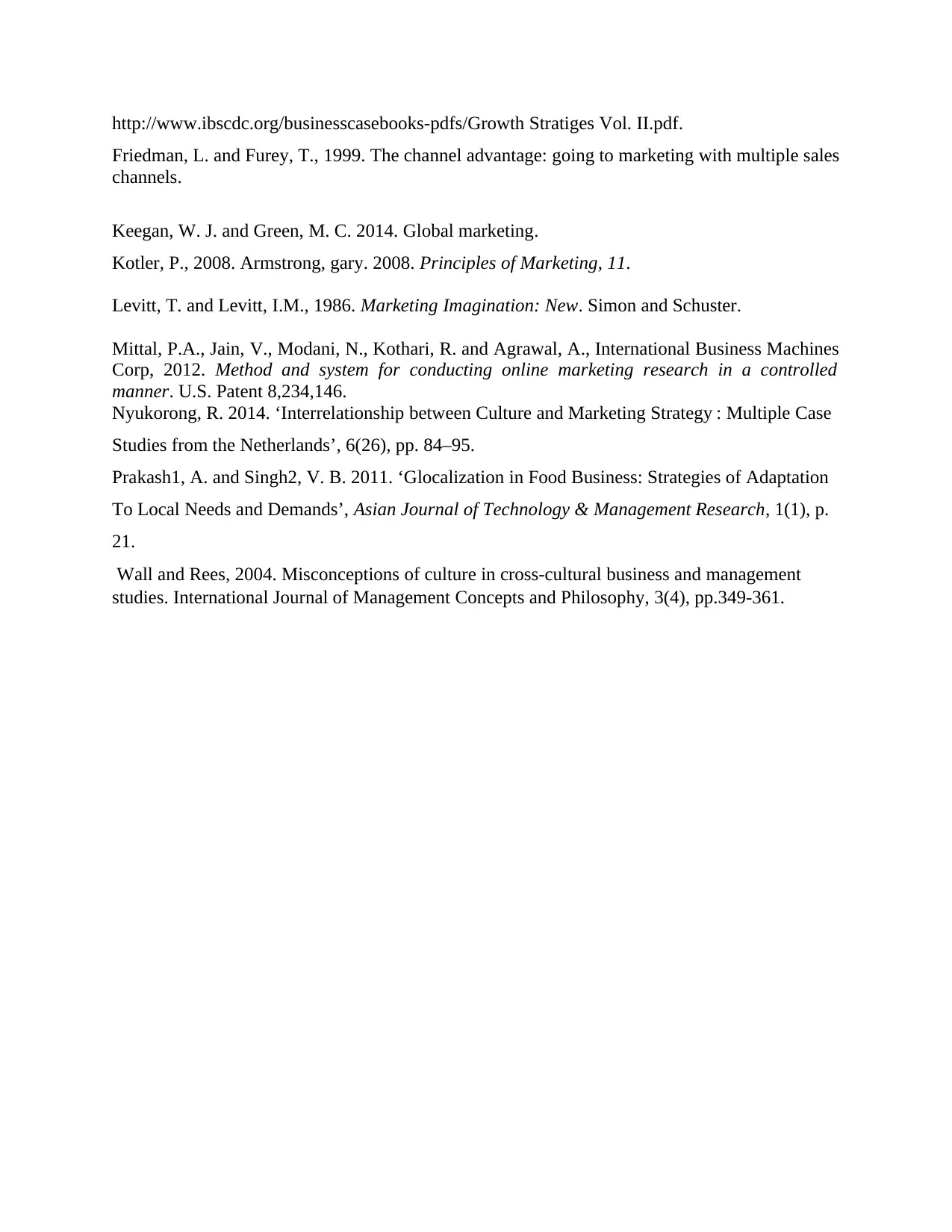
http://www.ibscdc.org/businesscasebooks-pdfs/Growth Stratiges Vol. II.pdf.
Friedman, L. and Furey, T., 1999. The channel advantage: going to marketing with multiple sales
channels.
Keegan, W. J. and Green, M. C. 2014. Global marketing.
Kotler, P., 2008. Armstrong, gary. 2008. Principles of Marketing, 11.
Levitt, T. and Levitt, I.M., 1986. Marketing Imagination: New. Simon and Schuster.
Mittal, P.A., Jain, V., Modani, N., Kothari, R. and Agrawal, A., International Business Machines
Corp, 2012. Method and system for conducting online marketing research in a controlled
manner. U.S. Patent 8,234,146.
Nyukorong, R. 2014. ‘Interrelationship between Culture and Marketing Strategy : Multiple Case
Studies from the Netherlands’, 6(26), pp. 84–95.
Prakash1, A. and Singh2, V. B. 2011. ‘Glocalization in Food Business: Strategies of Adaptation
To Local Needs and Demands’, Asian Journal of Technology & Management Research, 1(1), p.
21.
Wall and Rees, 2004. Misconceptions of culture in cross-cultural business and management
studies. International Journal of Management Concepts and Philosophy, 3(4), pp.349-361.
Friedman, L. and Furey, T., 1999. The channel advantage: going to marketing with multiple sales
channels.
Keegan, W. J. and Green, M. C. 2014. Global marketing.
Kotler, P., 2008. Armstrong, gary. 2008. Principles of Marketing, 11.
Levitt, T. and Levitt, I.M., 1986. Marketing Imagination: New. Simon and Schuster.
Mittal, P.A., Jain, V., Modani, N., Kothari, R. and Agrawal, A., International Business Machines
Corp, 2012. Method and system for conducting online marketing research in a controlled
manner. U.S. Patent 8,234,146.
Nyukorong, R. 2014. ‘Interrelationship between Culture and Marketing Strategy : Multiple Case
Studies from the Netherlands’, 6(26), pp. 84–95.
Prakash1, A. and Singh2, V. B. 2011. ‘Glocalization in Food Business: Strategies of Adaptation
To Local Needs and Demands’, Asian Journal of Technology & Management Research, 1(1), p.
21.
Wall and Rees, 2004. Misconceptions of culture in cross-cultural business and management
studies. International Journal of Management Concepts and Philosophy, 3(4), pp.349-361.
1 out of 10
Related Documents
Your All-in-One AI-Powered Toolkit for Academic Success.
+13062052269
info@desklib.com
Available 24*7 on WhatsApp / Email
![[object Object]](/_next/static/media/star-bottom.7253800d.svg)
Unlock your academic potential
© 2024 | Zucol Services PVT LTD | All rights reserved.





